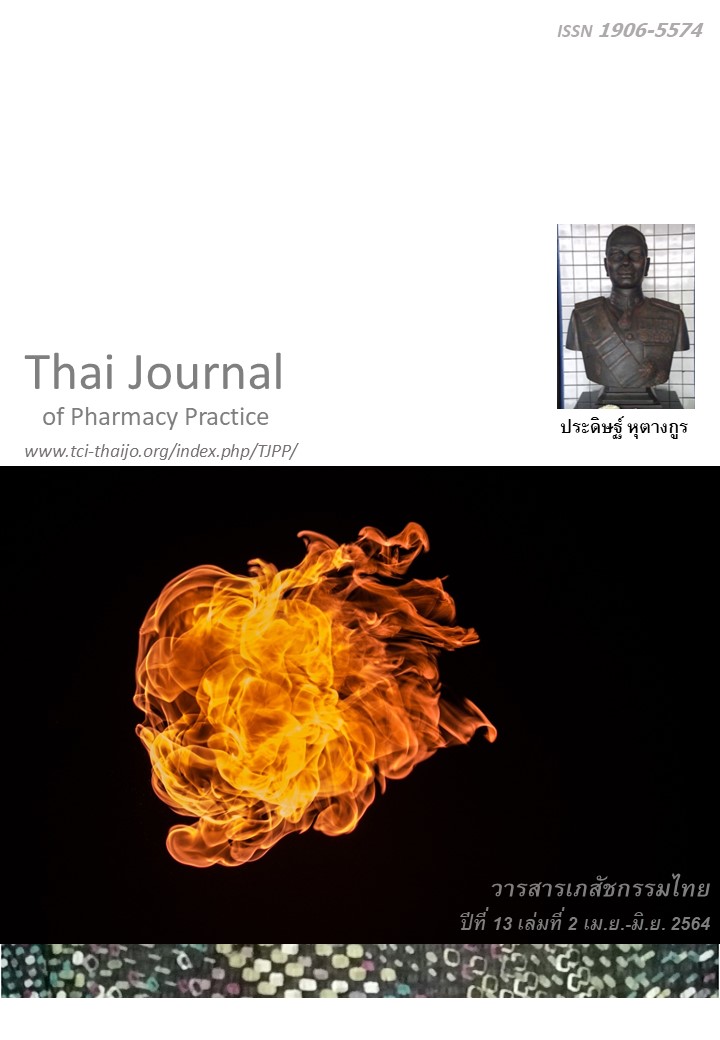ปัจจัยทำนายความร่วมมือในการใช้ยาของผู้ป่วยโรคความดันโลหิตสูง ในชุมชนแห่งหนึ่งของจังหวัดพะเยา
Main Article Content
บทคัดย่อ
วัตถุประสงค์: เพื่อศึกษาปัจจัยที่มีความสัมพันธ์กับความร่วมมือในการใช้ยาของผู้ป่วยโรคความดันโลหิตสูง วิธีการ: การศึกษานี้เป็นการวิจัยเชิงสำรวจแบบภาคตัดขวาง การศึกษารวบรวมข้อมูลจากเวชระเบียนและแบบสอบถามเกี่ยวกับปัจจัยด้านผู้ป่วย ปัจจัยภาวะสุขภาพ และประเมินความร่วมมือในการใช้ยาโดยใช้แบบสอบถาม ตัวอย่าง คือ ผู้ป่วยโรคความดันโลหิตสูง จำนวน 303 รายที่ได้รับการวินิจฉัยจากแพทย์และมารับการรักษาที่โรงพยาบาลส่งเสริมสุขภาพตำบลแห่งหนึ่งในจังหวัดพะเยา ระหว่างเดือนตุลาคม 2561 - กันยายน 2562 การเลือกตัวอย่างใช้วิธีสุ่มตัวอย่างแบบหลายขั้นตอนจากทะเบียนรายชื่อผู้ป่วยตามคุณสมบัติที่กำหนด การวิเคราะห์ปัจจัยทำนายความร่วมมือในการใช้ยาใช้ binary logistic regression ผลการวิจัย: ผู้ป่วยมีความร่วมมือในการใช้ยาระดับเพียงพอร้อยละ 73.27 จำนวนโรคร่วมและความรู้ที่เกี่ยวข้องกับโรคความดันโลหิตสูงสามารถร่วมกันทำนายความร่วมมือในการใช้ยาได้อย่างมีนัยสำคัญทางสถิติ (P<0.05) โดยมี odds ratio=0.57, 95% Cl=0.37-0.88 และ odds ratio=1.047, 95% Cl=1.03-1.39 ตามลำดับ สรุป: บุคคลากรทางการแพทย์ควรให้ความสำคัญกับปัจจัยด้านผู้ป่วยและปัจจัยภาวะสุขภาพที่มีความสัมพันธ์กับความร่วมมือในการใช้ยา ได้แก่ จำนวนโรคร่วมและความรู้ที่เกี่ยวข้องกับโรคความดันโลหิตสูงในการออกแบบกิจกรรมเพื่อส่งเสริมให้เกิดความร่วมมือในการใช้ยาในผู้ป่วยความดันโลหิตสูงอย่างเหมาะสม
Article Details
ผลการวิจัยและความคิดเห็นที่ปรากฏในบทความถือเป็นความคิดเห็นและอยู่ในความรับผิดชอบของผู้นิพนธ์ มิใช่ความเห็นหรือความรับผิดชอบของกองบรรณาธิการ หรือคณะเภสัชศาสตร์ มหาวิทยาลัยสงขลานครินทร์ ทั้งนี้ไม่รวมความผิดพลาดอันเกิดจากการพิมพ์ บทความที่ได้รับการเผยแพร่โดยวารสารเภสัชกรรมไทยถือเป็นสิทธิ์ของวารสารฯ
เอกสารอ้างอิง
Word Health Organization. Global Health Observa tory (GHO) data: raised blood pressure [online]. 2016. [cited Jan 27, 2020]. Available from: www. who.int/gho/ncd/risk_factors/blood_pressure_preva lence_text /en/
World Hypertension League Organization. Hyperten sion globally [online]. 2017. [cited Jan 27, 2020]. Available from: www.whleague.org/index.php/j-stuff /hypertension-globally
Division of Non-Communicable Disease. 2018 Hyper tension day issue [online]. 2018. [cited Jan 27, 2020 ] . Available from www.thaincd.com/2016/news/hot-news-detail.php?id=13106&gid=18
Phayao Provincial Public Health Office. Morbidity rate of hypertension per hundred thousand population [online]. 2020. [cited Jan 27, 2020]. Available from: pyo.hdc. moph.go.th/ hdc/main/ index_pk.php
Thai Hypertension Society. Guidelines in the treatment of hypertension 2019. Bangkok: Sahamirt printing and publishing; 2019.
Whelton PK, Carey RM, Aronow WS, Casey DE, Collins KJ, Dennison HC, et al. 2017 ACC/AHA/AAPA/ABC/ACPM/AGS/APhA/ASH/ASP C/NMA/PCNA guideline for the prevention, detection, evaluation, and management of high blood pressure in adults: executive summary: A report of the American college of cardiology/ American heart association task force on clinical practice guidelines. Circulation 2017; 138: e426-83.
Adisa R, Ilesanmi OA, Fakeye TO. Treatment adherence and blood pressure outcome among hypertensive out-patients in two tertiary hospitals in Sokoto, Northwestern Nigeria. BMC Cardiovasc Disord 2018; 18: 194.
Wangworatrakul W, Suwannaroop N, Moopayak K. Factor predicting to medication adherence among patients with essential hypertension. The Royal Thai Army Nurses 2017; 18: 131-39.
Woodham N, Taneepanichskul S, Somrongthong R. Medication adherence and associated factors among elderly hypertension patients with uncon- trolled blood pressure in rural area northeast Thailand. J Health Res 2018; 32: 449-57.
Abegaz TM, Shehab A, Gebreyohannes EA, Bhaga vathula AS, Elnour AA. Nonadherence to antihy pertensive drugs: A systematic review and meta-analysis. Medicine (Baltimore) 2017; 96: e5641.
Burnier M, Egan BM. Adherence in hypertension a review of prevalence, risk factors, impact, and management. Circ Res 2019; 124: 1124-40.
Suwannapong K, Klungrit S. Improving medication adherence in older persons with chronic illness. Royal Thai Navy Medical Journal 2019; 46: 717-31.
Hameed MA, Dasgupta I. Medication adherence and treatment-resistant hypertension: a review. Drugs Context. 2019; 8: 212560.
Leslie KH, McCowan C, Pell JP. Adherence to cardiovascular medication: a review of systematic reviews. J Public Health 2019; 41: e84-94.
Kongkaew C. Principle of strategies to promote medication adherence. Bangkok: Chulapress; 2018.
Phayao Provincial Public Health Office. Non-communicable disease data warehouse [online]. 2020. [cited Jan 27, 2020]. Available from: 203.20 9.96.247/chronic/
Krejcie, RV, Morgan DW. Determining sample size for research activities. Educ Psychol Meas 1970; 30: 607-10.
Chaikul C. Effects of self-management and family participation enhancing program on health behavior and blood pressure among elderly with hyper tension [master thesis]. Songkla: Prince of Songkla University; 2014.
Suphachamroon A, Lerkiatbundi S, Saengcharoen W. Validity and reliability of the medication adherence scale in Thais (MAST): Testing in diabetes patients. Thai Journal of Pharmacy Practice 2018; 10: 607-19.
Chaiyata E, Numkham L, Rakkapao N. The relationship between health literacy medication intake and doctoc’s appointment behavior among patient’s whit diabetes mellitus and hypertension in Lamphun province. Thai Science and Technology 2020; 28: 182-96.
Taengsakha K, Maneesriwongul W, Putawatana P. Factors related to adherence to treatment in essential hypertensive patients with early renal insufficiency. Ramathibodi Nursing Journal 2019: 25: 87-101.
Choi HY, Oh IJ, Lee JA, Lim J, Kim YS, Jeon TH, et al. Factors affecting adherence to antihyper tensive medication. Korean J Fam Med 2018; 39: 325-32.
Niriayo YL, Ibrahim S, Kassa TD, Asgedom SW, Atey TM, Gidey K, et al. Practice and predictors of self-care behaviors among ambulatory patients with hypertension in Ethiopia. PLoS One 2019; 14: e0218947.
Johnson MJ. The medication adherence model: a guide for assessing medication taking. Res Theory Nurs Pract 2002; 16: 179-92.


